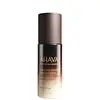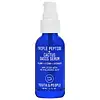What's inside
What's inside
 Key Ingredients
Key Ingredients

 Benefits
Benefits

 Concerns
Concerns

No concerns
 Ingredients Side-by-side
Ingredients Side-by-side

Water
Skin ConditioningCyclopentasiloxane
EmollientGlycerin
HumectantPvp
Emulsion StabilisingMaris Aqua
HumectantIsodecyl Isononanoate
EmollientCaprylyl Methicone
Skin ConditioningDimethicone
EmollientDiisobutyl Adipate
EmollientHydroxyethyl Acrylate/Sodium Acryloyldimethyl Taurate Copolymer
Emulsion StabilisingPropanediol
SolventTrehalose
HumectantPhenoxyethanol
PreservativePropylene Carbonate
SolventSodium Lactate
BufferingPEG-12 Dimethicone/PPG-20 Crosspolymer
Parfum
MaskingButylene Glycol
HumectantDimethiconol
EmollientDisteardimonium Hectorite
StabilisingHydrogenated Polydecene
EmollientGlucosyl Hesperidin
HumectantPentaerythrityl Tetra-Di-T-Butyl Hydroxyhydrocinnamate
AntioxidantCitric Acid
BufferingLactic Acid
BufferingHydrogenated Vegetable Glycerides Citrate
EmollientBeta-Sitosterol
Emulsion StabilisingGlycine Soja Oil
EmollientAscorbyl Palmitate
AntioxidantPropylene Glycol
HumectantLecithin
EmollientSodium Benzoate
MaskingPotassium Sorbate
PreservativeVitis Vinifera Seed Oil
EmollientAscorbic Acid
AntioxidantOlea Europaea Leaf Extract
PerfumingBiosaccharide Gum-1
HumectantTocopherol
AntioxidantCitrus Reticulata Fruit Extract
Skin ProtectingCitrus Aurantium Sinensis Peel Extract
Skin ConditioningCitrus Aurantium Amara Fruit Extract
Skin ConditioningEvodia Rutaecarpa Fruit Extract
Skin ConditioningSodium Hyaluronate
HumectantAloe Barbadensis Leaf Juice
Skin ConditioningSqualene
EmollientBisabolol
MaskingArgania Spinosa Kernel Oil
EmollientLaminaria Digitata Extract
Skin ProtectingCamellia Sinensis Leaf Extract
AntimicrobialPhoenix Dactylifera Fruit Extract
EmollientDunaliella Salina Extract
Skin ConditioningWater, Cyclopentasiloxane, Glycerin, Pvp, Maris Aqua, Isodecyl Isononanoate, Caprylyl Methicone, Dimethicone, Diisobutyl Adipate, Hydroxyethyl Acrylate/Sodium Acryloyldimethyl Taurate Copolymer, Propanediol, Trehalose, Phenoxyethanol, Propylene Carbonate, Sodium Lactate, PEG-12 Dimethicone/PPG-20 Crosspolymer, Parfum, Butylene Glycol, Dimethiconol, Disteardimonium Hectorite, Hydrogenated Polydecene, Glucosyl Hesperidin, Pentaerythrityl Tetra-Di-T-Butyl Hydroxyhydrocinnamate, Citric Acid, Lactic Acid, Hydrogenated Vegetable Glycerides Citrate, Beta-Sitosterol, Glycine Soja Oil, Ascorbyl Palmitate, Propylene Glycol, Lecithin, Sodium Benzoate, Potassium Sorbate, Vitis Vinifera Seed Oil, Ascorbic Acid, Olea Europaea Leaf Extract, Biosaccharide Gum-1, Tocopherol, Citrus Reticulata Fruit Extract, Citrus Aurantium Sinensis Peel Extract, Citrus Aurantium Amara Fruit Extract, Evodia Rutaecarpa Fruit Extract, Sodium Hyaluronate, Aloe Barbadensis Leaf Juice, Squalene, Bisabolol, Argania Spinosa Kernel Oil, Laminaria Digitata Extract, Camellia Sinensis Leaf Extract, Phoenix Dactylifera Fruit Extract, Dunaliella Salina Extract
Water
Skin ConditioningButylene Glycol
HumectantGlycerin
HumectantPentylene Glycol
Skin ConditioningOpuntia Ficus-Indica Stem Extract
Skin ConditioningPalmitoyl Tripeptide-1
Skin ConditioningPalmitoyl Tetrapeptide-7
Skin ConditioningPalmitoyl Tripeptide-28
Skin ConditioningSodium Hyaluronate
HumectantHydrolyzed Sodium Hyaluronate
Skin ConditioningSodium Hyaluronate Crosspolymer
HumectantSodium Acetylated Hyaluronate
HumectantSynthetic Sapphire
Citrullus Lanatus Fruit Extract
Skin ConditioningLens Esculenta Fruit Extract
Skin ConditioningPyrus Malus Fruit Extract
Skin ConditioningNephelium Lappaceum Peel Extract
Skin ConditioningSodium PCA
HumectantGlutathione
Malachite Extract
AntioxidantCitric Acid
BufferingHydroxypropyl Methylcellulose
Emulsion StabilisingTetrasodium Glutamate Diacetate
Polyglutamic Acid
Skin Conditioning1,2-Hexanediol
Skin ConditioningCaprylyl Glycol
EmollientSodium Lactate
BufferingCarbomer
Emulsion StabilisingPropanediol
SolventPolysorbate 20
EmulsifyingHydroxyethylcellulose
Emulsion StabilisingXanthan Gum
EmulsifyingPhenoxyethanol
PreservativeEthylhexylglycerin
Skin ConditioningWater, Butylene Glycol, Glycerin, Pentylene Glycol, Opuntia Ficus-Indica Stem Extract, Palmitoyl Tripeptide-1, Palmitoyl Tetrapeptide-7, Palmitoyl Tripeptide-28, Sodium Hyaluronate, Hydrolyzed Sodium Hyaluronate, Sodium Hyaluronate Crosspolymer, Sodium Acetylated Hyaluronate, Synthetic Sapphire, Citrullus Lanatus Fruit Extract, Lens Esculenta Fruit Extract, Pyrus Malus Fruit Extract, Nephelium Lappaceum Peel Extract, Sodium PCA, Glutathione, Malachite Extract, Citric Acid, Hydroxypropyl Methylcellulose, Tetrasodium Glutamate Diacetate, Polyglutamic Acid, 1,2-Hexanediol, Caprylyl Glycol, Sodium Lactate, Carbomer, Propanediol, Polysorbate 20, Hydroxyethylcellulose, Xanthan Gum, Phenoxyethanol, Ethylhexylglycerin
 Reviews
Reviews

Ingredients Explained
These ingredients are found in both products.
Ingredients higher up in an ingredient list are typically present in a larger amount.
Butylene Glycol (or BG) is used within cosmetic products for a few different reasons:
Overall, Butylene Glycol is a safe and well-rounded ingredient that works well with other ingredients.
Though this ingredient works well with most skin types, some people with sensitive skin may experience a reaction such as allergic rashes, closed comedones, or itchiness.
Learn more about Butylene GlycolCitric Acid is an alpha hydroxy acid (AHA) naturally found in citrus fruits like oranges, lemons, and limes.
Like other AHAs, citric acid can exfoliate skin by breaking down the bonds that hold dead skin cells together. This helps reveal smoother and brighter skin underneath.
However, this exfoliating effect only happens at high concentrations (20%) which can be hard to find in cosmetic products.
Due to this, citric acid is usually included in small amounts as a pH adjuster. This helps keep products slightly more acidic and compatible with skin's natural pH.
In skincare formulas, citric acid can:
While it can provide some skin benefits, research shows lactic acid and glycolic acid are generally more effective and less irritating exfoliants.
Most citric acid used in skincare today is made by fermenting sugars (usually from molasses). This synthetic version is identical to the natural citrus form but easier to stabilize and use in formulations.
Read more about some other popular AHA's here:
Learn more about Citric AcidGlycerin is already naturally found in your skin. It helps moisturize and protect your skin.
A study from 2016 found glycerin to be more effective as a humectant than AHAs and hyaluronic acid.
As a humectant, it helps the skin stay hydrated by pulling moisture to your skin. The low molecular weight of glycerin allows it to pull moisture into the deeper layers of your skin.
Hydrated skin improves your skin barrier; Your skin barrier helps protect against irritants and bacteria.
Glycerin has also been found to have antimicrobial and antiviral properties. Due to these properties, glycerin is often used in wound and burn treatments.
In cosmetics, glycerin is usually derived from plants such as soybean or palm. However, it can also be sourced from animals, such as tallow or animal fat.
This ingredient is organic, colorless, odorless, and non-toxic.
Glycerin is the name for this ingredient in American English. British English uses Glycerol/Glycerine.
Learn more about GlycerinPhenoxyethanol is a preservative that has germicide, antimicrobial, and aromatic properties. Studies show that phenoxyethanol can prevent microbial growth. By itself, it has a scent that is similar to that of a rose.
It's often used in formulations along with Caprylyl Glycol to preserve the shelf life of products.
Propanediol is an all-star ingredient. It softens, hydrates, and smooths the skin.
It’s often used to:
Propanediol is not likely to cause sensitivity and considered safe to use. It is derived from corn or petroleum with a clear color and no scent.
Learn more about PropanediolSodium Hyaluronate is hyaluronic acid's salt form. It is commonly derived from the sodium salt of hyaluronic acid.
Like hyaluronic acid, it is great at holding water and acts as a humectant. This makes it a great skin hydrating ingredient.
Sodium Hyaluronate is naturally occurring in our bodies and is mostly found in eye fluid and joints.
These are some other common types of Hyaluronic Acid:
Learn more about Sodium HyaluronateSodium Lactate is the sodium salt of lactic acid, an AHA. It is a humectant and sometimes used to adjust the pH of a product.
This ingredient is part of our skin's NMF, or natural moisturizing factor. Our NMF is essential for the hydration of our top skin layers and plasticity of skin. NMF also influences our skin's natural acid mantle and pH, which protects our skin from harmful bacteria.
High percentages of Sodium Lactate can have an exfoliating effect.
Fun fact: Sodium Lactate is produced from fermented sugar.
Learn more about Sodium LactateWater. It's the most common cosmetic ingredient of all. You'll usually see it at the top of ingredient lists, meaning that it makes up the largest part of the product.
So why is it so popular? Water most often acts as a solvent - this means that it helps dissolve other ingredients into the formulation.
You'll also recognize water as that liquid we all need to stay alive. If you see this, drink a glass of water. Stay hydrated!
Learn more about Water